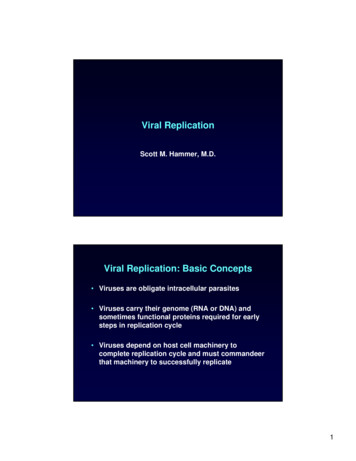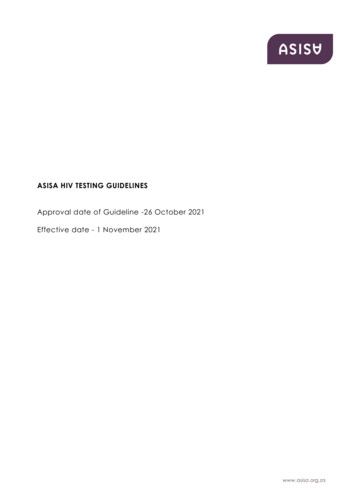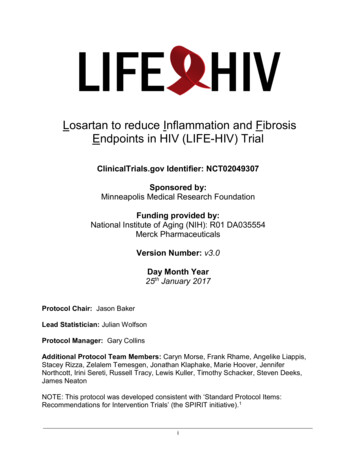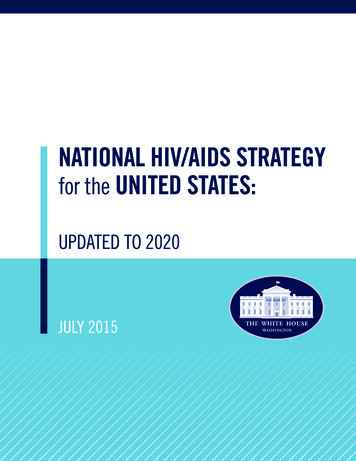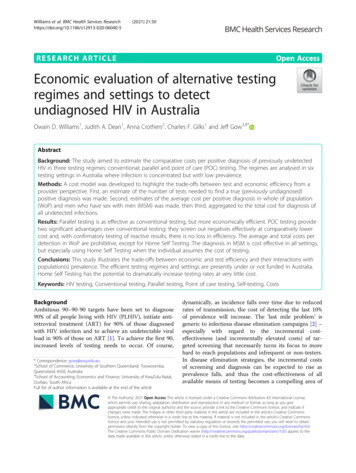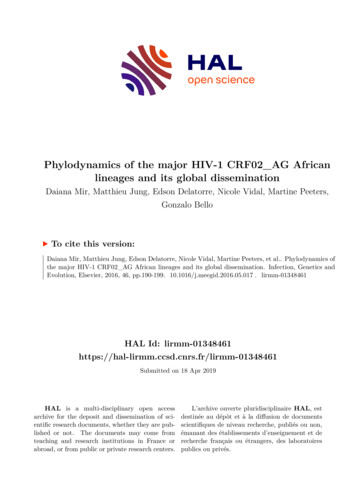
Transcription
Phylodynamics of the major HIV-1 CRF02 AG Africanlineages and its global disseminationDaiana Mir, Matthieu Jung, Edson Delatorre, Nicole Vidal, Martine Peeters,Gonzalo BelloTo cite this version:Daiana Mir, Matthieu Jung, Edson Delatorre, Nicole Vidal, Martine Peeters, et al. Phylodynamics ofthe major HIV-1 CRF02 AG African lineages and its global dissemination. Infection, Genetics andEvolution, Elsevier, 2016, 46, pp.190-199. 10.1016/j.meegid.2016.05.017 . lirmm-01348461 HAL Id: -01348461Submitted on 18 Apr 2019HAL is a multi-disciplinary open accessarchive for the deposit and dissemination of scientific research documents, whether they are published or not. The documents may come fromteaching and research institutions in France orabroad, or from public or private research centers.L’archive ouverte pluridisciplinaire HAL, estdestinée au dépôt et à la diffusion de documentsscientifiques de niveau recherche, publiés ou non,émanant des établissements d’enseignement et derecherche français ou étrangers, des laboratoirespublics ou privés.
Phylodynamics of the major HIV-1 CRF02 AG African lineages and its globaldisseminationDaiana Mir, Matthieu Jung, Edson Delatorre, Nicole Vidal, MartinePeeters, Gonzalo BelloPII:DOI:Reference:S1567-1348(16)30189-7doi: 10.1016/j.meegid.2016.05.017MEEGID 2750To appear in:Received date:Revised date:Accepted date:4 February 20169 May 201611 May 2016Please cite this article as: Mir, Daiana, Jung, Matthieu, Delatorre, Edson, Vidal, Nicole,Peeters, Martine, Bello, Gonzalo, Phylodynamics of the major HIV-1 CRF02 AG Africanlineages and its global dissemination, (2016), doi: 10.1016/j.meegid.2016.05.017This is a PDF file of an unedited manuscript that has been accepted for publication.As a service to our customers we are providing this early version of the manuscript.The manuscript will undergo copyediting, typesetting, and review of the resulting proofbefore it is published in its final form. Please note that during the production processerrors may be discovered which could affect the content, and all legal disclaimers thatapply to the journal pertain.
ACCEPTED MANUSCRIPTTITLE: Phylodynamics of the major HIV-1 CRF02 AG African lineages and itsTglobal dissemination.IPAUTHORS: Daiana Mira, Matthieu Jungb,c,1, Edson Delatorrea, Nicole Vidalb, MartineSCRPeetersb,c and Gonzalo Belloa#AFFILIATIONS:aLaboratório de AIDS & Imunologia Molecular, Instituto Oswaldo Cruz, FIOCRUZ,bNURio de Janeiro, Brazil.Unité Mixte Internationale 233, Institut de Recherche pour le Développement,cInstitut de Biologie Computationnelle, LIRMM, UMR 5506 CNRS – UniversitéMontpellier, Montpellier, France.Current address: IGBMC (Institut de Génétique et de Biologie Moléculaire etD1MAINSERM U1175, and Université Montpellier, Montpellier, France.TECellulaire), INSERM, U596, CNRS, UMR7104, Université de Strasbourg, Illkirch,CEPFrance.AC#Corresponding author:Gonzalo Bello. Lab. de AIDS & Imunologia Molecular, Instituto Oswaldo Cruz,FIOCRUZ. Av. Brasil 4365, 21045-900 Rio de Janeiro, RJ, Brazil. Phone: 55 21 38658107. Fax: 55 21 3865 8173. E-mail: gbellobr@gmail.com / gbello@ioc.fiocruz.br1
ACCEPTED MANUSCRIPTABSTRACTThe HIV-1 CRF02 AG clade is the most prevalent HIV variant in West and West-TCentral Africa and its detection outside Africa is increasingly common. Little is known,IPhowever, about the number and phylodynamics of major CRF02 AG lineagesSCRcirculating worldwide. To this end, a total of 3,170 HIV-1 CRF02 AG-like polsequences isolated around the world, over a period of 25 years (1989 to 2013), wereanalyzed using Maximum Likelihood and Bayesian coalescent-based methods. OurNUresults suggest that most of the current CRF02 AG diversity comes from theMAdissemination of a few founder strains out of Central Africa into West Africa andCameroon between the late 1960s and the middle 1980s. The CRF02 AG strainintroduced into West Africa established a large regional epidemic with lowTEDphylogeographic structure. This strain was also successfully disseminated out of theWest African region and originated at least three large secondary outbreaks inCEPCameroon at around the late 1970s, in the former Soviet Union (FSU) countries ataround the late 1990s, and in Bulgaria/Germany at around the early 2000s. TheACCRF02 AG African lineages introduced into Cameroon remained mostly restricted tothis country and its neighbors. Demographic reconstructions indicate that majorCRF02 AG clades circulating in Africa exhibited a decline in growth rate since themiddle 1980s/1990s, whereas CRF02 AG clades in Europe and the FSU countriescontinue to grow exponentially until the middle to late 2000s. Substantial differences inthe median estimated growth rate of the same CRF02 AG clade circulating in differentregions (0.63–2.00 year-1), and of different CRF02 AG clades circulating in the samecountry (0.41–0.75 year-1) were observed. Thus, the cause of the epidemic outcome ofthe different HIV-1 CRF02 AG lineages is probably multifactorial.KEYWORDS: HIV-1; CRF02 AG; Africa; worldwide; phylodynamics.2
ACCEPTED MANUSCRIPT1. INTRODUCTIONThe epidemic dispersion of HIV-1 group M from its location root in Kinshasa, capital ofTthe Democratic Republic of the Congo (DRC), since the first part of the 20th centuryIP(Faria et al., 2014) has resulted in the extensive diversity of subtypes, sub-subtypes,SCRcirculating recombinant forms (CRFs) and unique recombinant forms (URFs) reportedacross the world. Among the 79 CRFs currently described, CRF02 AG is responsiblefor the largest number of infections worldwide and is the fourth most prevalent HIV-1NUvariant accounting for 8% of the global infections (Hemelaar et al., 2011).MAThe CRF02 AG variant predominates in West and West-Central African countrieswhere it stand for about 50% of the HIV-1 infections (Hemelaar et al., 2011; Lihana etal., 2012); but there is a notable decrease in its frequencies toward Central Africa whereTEDit display a prevalence of around 8% of the total infections (Hemelaar et al., 2011;Peeters et al., 2003) and is rarely detected in other African regions. In recent years, thereCEPhas been an increase in reported sporadic CRF02 AG cases in Europe and NorthAmerica, mostly caused by migrant flows from endemic regions and global travelAC(Abecasis et al., 2013; European Centre for Disease Prevention and Control (ECDC),2014; Hernando et al., 2015; Pyne et al., 2013).A few indigenous transmission networks of CRF02 AG have been also detected indifferent regions out of Africa. Autochthonous transmission networks of CRF02 AGhave arisen in former Soviet Union (FSU) countries mainly distributed amongintravenous drug users (IVDUs), but with increasing prevalence into heterosexualpopulations (Baryshev et al., 2012; Carr et al., 2005; Eyzaguirre et al., 2007; Kazennovaet al., 2014; Laga et al., 2015; Lapovok et al., 2014). Local dissemination ofCRF02 AG has been also detected in Brazil, where it has shown the existence of atleast two transmission networks with dissemination by both horizontal and vertical3
ACCEPTED MANUSCRIPTpathways (Delatorre et al., 2015, 2012; Eyer-Silva and Morgado, 2007). Moreover,recent analysis evidence the existence of some native CRF02 AG transmission clustersTparticularly among HIV-infected men having sex with men (MSM) from France andSCRal., 2015; Tamalet et al., 2015; Von Wyl et al., 2011).IPBelgium and heterosexual population from Switzerland (Brand et al., 2014; Dauwe etThe field of viral phylodynamics coupled with coalescent-based models has become apowerful tool allowing the recognition of the spatiotemporal dynamics of a variety ofNUviruses and its implementation helped elucidate the origin and dispersion pattern of theMACRF02 AG lineage in the Congo River basin (Faria et al., 2012), as well as thedemographic dynamics and/or migration routes of CRF02 AG circulating in GuineaBissau, Cameroon and Brazil (Delatorre et al., 2015; Esbjörnsson et al., 2011; Faria etTEDal., 2012; Véras et al., 2011). The spatiotemporal pattern of dissemination of theCRF02 AG at a global scale, however, remains largely unknown.CEPThe objectives of the present study were to identify and characterize the major HIV-1CRF02 AG clades circulating in West, West-Central and Central Africa and theirACdispersion at both regional and global scales. Spatial and temporal information of 3,170CRF02 AG-like pol sequences sampled worldwide over a period of 25 years were usedin maximum-likelihood and coalescent-based phylodynamic approaches to determinethe prevalence of the major HIV-1 CRF02 AG clades and to reconstruct simultaneouslytheir evolutionary and demographic histories.2. MATERIALS AND METHODS2.1. HIV-1 CRF02 AG-like pol sequence datasets. A total of 2,246 HIV-1CRF02 AG-like pol sequences, covering the entire protease and partial reversetranscriptase (PR/RT) regions (nucleotides 2,253-3,260 relative to HXB2 genome),4
ACCEPTED MANUSCRIPTisolated from 20 countries from Central, West-Central and West Africa over a period of24 years (1990 to 2013) were used in this study (Table S1). Sequences were retrievedTfrom the Los Alamos HIV Database (n 2,113) (http://www.hiv.lanl.gov) and from aIPlocal database at the Institut de Recherche pour le Développement, UniversitéSCRMontpellier (n 133). These African sequences were combined with 924 CRF02 AGlike pol sequences isolated from 43 countries from the Americas, Europe, Asia andOceania and with 38 CRF63 02A1-like pol sequences isolated in Russia, covering theNUsame genomic region described above and that were available at the Los Alamos HIVMADatabase (Table S1). The subtype assignment of all sequences was confirmed usingCOMET (Struck et al., 2014) and REGAv3.0 (de Oliveira et al., 2005). Sequences withdiscordant results were further submitted to Maximum Likelihood (ML) phylogeneticTEDanalysis (see bellow) and Bootscan analysis (Lole et al., 1999) with reference samples.All sites with major antiretroviral drug resistance mutations were excluded, leaving 921CEPnucleotides in the final alignment that is available from authors upon request.2.2. Phylogenetic analyses. ML trees were inferred with the PhyML v3.0 programAC(Guindon et al., 2010), under the GTR I Г4 model of nucleotide substitutionrecommended by the jModeltest program (Posada and Crandall, 2001). The SubtreePruning and Regrafting (SPR) option was selected as the heuristic tree search methodand branch support was estimated with the approximate likelihood-ratio (aLRT) SHlike test (Anisimova and Gascuel, 2006). Reference sequences of HIV-1 subtypes B, C,D, F, H, J and K from the Los Alamos HIV Database were used as outgroup. 2(http://tree.bio.ed.ac.uk/software/figtree/). Major CRF02 AG monophyletic clusterswere identified by visual inspection and only those including more than 30 sequencesand an aLRT score over 0.85 were selected for further analysis.5
ACCEPTED MANUSCRIPT2.3 Evolutionary and demographic reconstructions. For each CRF02 AG cladeidentified, the evolutionary rate (μ, units are nucleotide substitutions per site per year,subst./site/year), age of most recent common ancestor (Tmrca, years), and mode and rateIPT(r, years 1) of population growth were coestimated by a Bayesian Markov Chain MonteSCRCarlo (MCMC) coalescent-based phylodynamic analyses as implemented in BEASTv1.8 (Drummond and Rambaut, 2007) with BEAGLE (Suchard and Rambaut, 2009) toimprove run performance. Since this methodology is computationally prohibitive onNUlarge datasets, those identified clades made up by more than 500 sequences weresubjected to a sub-sampling strategy (see Supplementary Material for full details of theMAprocedure). Analyses were carried out under the GTR I Г4 model of nucleotidesubstitution and a relaxed uncorrelated lognormal molecular clock model (DrummondTEDet al., 2006). A uniform prior was applied on the clock rate (1.5-3.0 x 10-3subs./site/year) on the basis of estimations reported from previous studies (Abecasis etCEPal., 2009). The dynamics of the effective population size (Ne) over time were initiallyestimated by the non-parametric Bayesian skyline plot model (BSP) (Drummond et al.,AC2005) as coalescent tree prior. Parametric estimates of the growth rates were obtainedunder three demographic models (exponential, logistic and expansion growth) whoseadjustment to the data were assessed using the log marginal likelihood estimation(MLE) based on path sampling (PS) and stepping-stone sampling (SS) approaches(Baele et al., 2012). MCMC were run for 5-50 x 107 generations to ensure EffectiveSample Size (ESS) values above 200. The ESS and the 95% Highest . Maximum clade credibility (MCC) trees weresummarized using TreeAnnotator v1.8 and visualized with FigTree v1.4.2.6
ACCEPTED MANUSCRIPT3. RESULTS3.1 Characterization of major HIV-1 CRF02 AG clades circulating in Africa.TThe ML phylogenetic analysis performed with 2,246 HIV-1 CRF02 AG-like polIPsequences from 20 different African countries revealed the existence of five majorSCRstrongly supported (aLRT 0.85) clades within the radiation of the CRF02 AG (Fig. 1).The clades CRF02CM-I, CRF02CM-II, CRF02CM-III and CRF02CM-IV mostly circulate inCameroon and together comprise 81% of the CRF02 AG sequences from that country,NUwhereas the clade CRF02WA is the most prevalent one circulating in West Africa andI,MAcomprises 98% of the CRF02 sequences from that region. Clades CRF02WA, CRF02CMCRF02CM-III and CRF02CM-IV were nested among basal sequences from Central Africaand probably represent independent introductions of CRF02 AG strains from CentralTEDAfrica into West Africa and Cameroon. The clade CRF02CM-II, by contrast, was nestedwithin the CRF02WA clade and probably resulted from a secondary dissemination eventCEPof a CRF02WA strain from West Africa into Cameroon.Analysis of the relative prevalence of major CRF02 AG clades across African countriesACrevealed the existence of four different epidemiologic scenarios (Fig. 2 and Table S2).The CRF02 AG epidemic in Central Africa was mainly composed by basal CRF02 AGlineages (60%), followed by the CRF02WA clade (24%). The CRF02 AG epidemic inWest Africa was clearly dominated by the CRF02WA clade (98%). In Gabon andEquatorial Guinea, the CRF02WA clade also predominated ( 62%), but a significantfraction of sequences ( 14%) branched inside the Cameroonian clades CRF02CM-I andCRF02CM-II. In Cameroon, the CRF02 AG epidemic was dominated by cladesCRF02CM-I and CRF02CM-II (71%), and also by a substantial proportion of strains fromCRF02WA clade (19%). Despite its variable prevalence (ranging from 19% to 100%),the CRF02WA clade was detected in all African countries analyzed.7
ACCEPTED MANUSCRIPT3.2. Worldwide dissemination of the major HIV-1 CRF02 AG African clades.To investigate the role played by each major African CRF02 AG clade in the globalTdissemination of CRF02 AG, a worldwide set of CRF02 AG-like pol gene sequencesIPwas subjected to ML phylogenetic analyses, alongside a reference alignment consistingSCRof randomly selected African sequences representative of the major clades. Thephylogenetic reconstruction essentially recovered the five major monophyleticCRF02 AG groups (aLRT 0.85) previously identified, with global samples branchingNUwithin them (Fig. 3). The level of global geographic dispersion observed among thedifferent African CRF02 AG clades varied widely (Fig. 4 and Table S2). The majorityMA( 84%) of the CRF02 AG sequences detected in the Americas, Asia and Europebranched inside the CRF02WA clade. The clades CRF02CM-I and CRF02CM-II togetherTEDcomprised between 4% and 17% of the CRF02 AG infections out of Africa, whereasthe clades CRF02CM-III and CRF02CM-IV were only detected in Europe and at very lowCEPprevalence ( 1%).The ML phylogenetic reconstruction using the global HIV-1 CRF02 AG-like polACsequences also revealed two major non-African strongly supported (aLRT 0.99)monophyletic sub-clades within the CRF02WA radiation (Fig. 3). The sub-cladeCRF02BG-DE included sequences sampled from Bulgaria and Germany between 2006and 2012, whereas the sub-clade CRF02FSU was composed by sequences from theformer Soviet Union (FSU) countries (Russia, Armenia, Kazakhstan, Uzbekistan andUkraine) isolated between 2002 and 2013. Smaller (n 20 sequences) country-specificmonophyletic sub-clades within the CRF02WA radiation were also detected in otherscountries (data not shown). These results corroborate the existence of autochthonoustransmission networks of CRF02 AG out of Africa that resulted from the introductionand local dissemination of the CRF02WA clade.8
ACCEPTED MANUSCRIPT3.3. Phylogenetic relationship between CRF02FSU and CRF63 02A1 clades.The CRF63 02A1 is a HIV-1 variant mainly spreading among IDUs and heterosexualTpopulations from the Russian Federation that was generated by recombination betweenIPthe CRF02 AG and the subtype A1 clades (Baryshev et al., 2012; Gashnikova et al.,SCR2015; Kazennova et al., 2014; Shcherbakova et al., 2014) This CRF displays aCRF02 AG-like profile in the pol gene fragment here selected, which may complicatethe subtyping of HIV-1 CRF02 AG-like sequences from FSU countries. To test this,NUpol sequences classified within the CRF02FSU clade were aligned with CRF63 02A1MAsequences and with CRF02 AG African sequences representative of the major cladesidentified in this study. The ML phylogenetic analysis showed that CRF02 AG-likesequences from Armenia, Kazakhstan, Uzbekistan and Ukraine branched at the base ofTEDthe CRF02FSU clade (Fig. 5). Most Russian sequences, by contrast, are intermixed withCRF63 02A1 viruses in a monophyletic subclade nested within basal CRF02FSUCEPlineages and were thus reclassified as CRF63 02A1-like viruses.3.4. Timescale and demographic history of CRF02 AG and CRF63 02A1 clades.ACThe evolutionary and demographic history of major CRF02 AG African clades and ofCRF02BG-DE, CRF02FSU and CRF63 02A1 clades was reconstructed using a Bayesiancoalescent-based approach. The CRF02WA clade was subjected to a sub-samplingstrategy because of its large size (n 1,507), resulting in six subsets (see supplementarymaterial) each of which underwent the same analytical pipeline of the other clades. Themedian estimated evolutionary rate of the different clades were roughly comparable andall displayed a coefficient of rate variation that did not encompass zero (Tables 1 andS3), thus justifying the use of the relaxed molecular clock model. According to thesubstitution rates here estimated, the median TMRCA of the different clades dated back tobetween the late 1960s and the middle 2000s (Tables 1 and S3).9
ACCEPTED MANUSCRIPTThe demographic history estimated through the nonparametric BSP model, suggestedthat all CRF02 AG clades as well as the CRF63 02A1 clade underwent an initialTperiod of substantial population expansion, followed by a more recent slowdown in itsIPrates of spread (Fig. 6). The growth rate seems to start to decrease between 1985 andSCR1995 for African CRF02 AG clades, around the middle 2000s for the CRF02FSU cladeand around the late 2000s for CRF02BG-DE and CRF63 02A1 clades. To test thesignificance of such a recent decline in the epidemic growth rate, different parametricNUgrowth models were compared for each clade. The logistic growth model provided theMAbest fit to the demographic signal contained in all African CRF02 AG clades and in theCRF63 02A1 clade, whereas the demographic signal contained in the CRF02FSU andCRF02BG-DE clades was nearly equally fitted by both logistic and exponential growthTEDmodels (Table S4). The median estimated logistic growth rates of major CRF02 AGAfrican clades (0.41 year-1 to 0.75 year-1) were much lower than those estimated forCEPCRF02 AG and CRF63 02A1 clades circulating in Europe and Asia (1.74 year-1 to 2.20year-1) (Tables 1 and S3). According to the exponential growth model, however, theACmedian epidemic growth rates of the CRF02FSU (0.40 year-1) and CRF02BG-DE (0.83year-1) clades were lower than those estimated by the logistic one (Table 1).4. DISCUSSIONThe present study embodies a major step toward the identification of the main HIV-1CRF02 AG lineagescirculating worldwide andthe characterization of itsspatiotemporal dynamics of dissemination. The analyses carried out with 3,170CRF02 AG-like pol sequences sampled around the world support that the currentdiversity of this HIV-1 variant mostly resulted from the expansion of a few clades withdifferent epidemic outcomes.10
ACCEPTED MANUSCRIPTThe major CRF02 AG African lineage identified here, called CRF02WA, probably aroseafter the introduction of a single founder strain from Central Africa into West Africa.TThis founder strain was disseminated throughout West Africa since the late 1960sIPonwards, establishing a large regional epidemic that comprises about 98% of theSCRCRF02 AG sequences from that region here included and displays a very weakgeographical structure characterized by country-specific sub-clades of small size (n 10sequences). The weak phylogeographic structure of the CRF02WA clade reflectsNUmultiple and frequent viral exchanges among West African countries that is fullyMAconsistent with the strong spatial accessibility (Tatem et al., 2012) and the frequenthuman mobility (Charrièrre and Fresia, 2008; Gnisci and Trémolieres, 2009) betweencountries from the West African region, and also coincides with the weakTEDphylogeographic structure observed for other HIV-1 lineages (subtype G andCRF06 cpx) circulating in that region (Delatorre et al., 2014a, 2014b).CEPOther major CRF02 AG African clades identified here (CRF02CM-I, CRF02CM-III andCRF02CM-IV), seems to be the result of the expansion of three founder strains probablyACintroduced into Cameroon from Central Africa. The estimated emergence of theseCRF02 AG Cameroonian clades encompass a period of almost two decades, rangingfrom the late 1960s for CRF02CM-I to the middle 1980s for CRF02CM-III and CRF02CMIV.Previous studies described the existence of two (Faria et al., 2012) and three (Véraset al., 2011) major CRF02 AG clades circulating in Cameroon that coincide with cladesCRF02CM-I/CRF02CM-II and CRF02CM-I/CRF02CM-II/CRF02CM-III detected in this study,respectively. The greater number of CRF02 AG Cameroonian lineages detected herecompared to those previously reported probably arose from the larger number ofsequences used in this new study.11
ACCEPTED MANUSCRIPTThe CRF02WA clade was not only successfully disseminated within the West Africanregion, but was also introduced multiple times into other regions of Africa and intoTother countries around the world, originating a number of secondary outbreaks. TheIPlargest secondary CRF02WA outbreaks were detected in Cameroon, Bulgaria/GermanySCRand countries from the FSU, leading to the origin of sub-clades called here CRF02CM-II,CRF02BG-DE and CRF02FSU, respectively, which were nested within the CRF02WAradiation. The CRF02WA clade and the descendant sub-clades comprise a significantNUproportion of sequences from West-Central Africa ( 40%), Central Africa (24%), andMAother regions around the world ( 84%). Thus, the CRF02WA clade is the mostsuccessfully disseminated CRF02 AG lineage at a global scale.The chance of exportation of the CRF02 AG virus from West-Central and CentralTEDAfrican regions seems to be much lower than from West Africa. The CameroonianCRF02 AG clades (CRF02CM-I, CRF02CM-II, CRF02CM-III and CRF02CM-IV) reach a highCEPprevalence in Cameroon (81%) and the neighboring Gabon (38%), but comprise only aminor fraction of the CRF02 AG sequences detected in Angola and DRC (16%),ACEurope (16%), Equatorial Guinea (14%), America (13%), Asia/Oceania (4%), and WestAfrica (2%). Similarly, basal CRF02 AG lineages that are prevalent in Angola andDRC (60%) were barely detected outside this region. Given that West Africa hosts amuch larger number of CRF02 AG-infected people ( 2,500,000) than Cameroon( 330,000) and Central African countries ( 100,000) (Hemelaar et al., 2011; Lihana etal., 2012), a more frequent exportation of the CRF02WA clade out of the epicenter likethe one supported by our results would be expected.Demographic reconstructions indicate that major African CRF02 AG clades displayeda similar population growth pattern characterized by an initial phase of exponentialgrowth followed by a decline in growth rate since the middle 1980s-1990s onwards.12
ACCEPTED MANUSCRIPTThe median growth rate of the CRF02WA clade (0.63 year-1) was somewhat lower thanthose previously estimated for subtype G clades and the CRF06 cpx lineage circulatingTin West Africa (0.75-0.95 year-1) (Delatorre et al., 2014a, 2014b) (Fig. S1). Similarly,IPthe median growth rate of different CRF02 AG lineages circulating in Cameroon alsoSCRvaried over a large range (0.41-0.75 year-1). Although these results should be interpretedwith caution because of the overlap of HPD intervals (Table 1), they support that spatialaccessibility may not the only factor that shaped the rate of expansion of the differentNUHIV-1 clades circulating in those African regions. Differences in the onset date ofMAepidemics, transmission dynamics in distinct risk groups and/or viral transmissibilityproperties might be also responsible for the growth rate variances observed.Our analyses revealed the existence of two major CRF02 AG transmission networksTEDoutside Africa involving individuals from Bulgaria/Germany (CRF02BG-DE) and FSUcountries (CRF02FSU) that probably arose at around the early 2000s and the late 1990s,CEPrespectively. Although none of these countries host a large number of West Africanmigrants (Charrièrre and Fresia, 2008), molecular epidemiologic studies showed thatACCRF02 AG infections detected in Bulgaria (Ivanov et al., 2013) as well as inKazakhstan (Eyzaguirre et al., 2007; Lapovok et al., 2014), Uzbekistan (Carr et al.,2005), Kyrgyzstan (Laga et al., 2015), and the Russian Federation (Kazennova et al.,2014) were preferentially associated to IVDUs populations. Given the epidemiologicallink between the CRF02 AG and IVDUs transmission networks described in the abovecountries, the origin of clades CRF02BG-DE and CRF02FSU could have been shaped bythe rise of international heroin traffic routes linking Afghanistan (the world largestopium producer) to the markets of the Russian Federation and Western Europe(UNODC, 2008).13
ACCEPTED MANUSCRIPTThe HIV-1 epidemic in IVDUs from FSU countries has been mainly driven by asubtype A1 variant characteristic of that region (AFSU), that probably began to spreadTamong IVDUs from Ukraine in the early 1990s and was later disseminated to other FSUIPcountries (Díez-Fuertes et al., 2015). According to our estimations, the CRF02FSUSCRvariant began to spread in FSU countries around the late 1990s, probably resulting in ahigh number of co-infections with the AFSU variant already circulating and thesubsequent generation of the AFSU/CRF02FSU recombinant called CRF63 02A1 clade.NUWe estimated the origin of the CRF63 02A1 clade around the middle 2000s, consistentMAwith a previous study (Shcherbakova et al., 2014), supporting a very short time interval( 10 years) between the emergence of the CRF02FSU lineage and the origin of theCRF63 02A1 clade in the IVDUs from FSU countries.TEDInspection of the BSP of the CRF02BG-DE, CRF02FSU and CRF63 02A1 clades supportsa trend toward very recent epidemic stabilization since 2005-2010. The median logisticCEPgrowth rate estimated for these clades circulating in European and FSU countries werevery similar among each other (1.74-2.20 year-1) and between three and five times fasterACthan those estimated for African CRF02 AG clades. These extremely fast epidemicgrowth rates are fully consistent with the preferential dissemination of CRF02BG-DE,CRF02FSU and CRF63 02A1 clades through highly connected IVDUs transmissionnetworks, in contrast to the African CRF02 AG clades that are mainly disseminatedthrough heterosexual networks. The exponential demographic model, however, alsoprovide a good fit to the demographic signal in the CRF02FSU and CRF02BG-DE cladesand supports lower epidemic expansion rates than those estimated by the logistic model.It is possible that the logistic pattern of the CRF02FSU and CRF02BG-DE clades was moredifficult to capture due to its recent stabilization and/or low number of sequences,although we cannot ruled out that those epidemics are still growing exponentially.14
ACCEPTED MANUSCRIPT5. CONCLUSIONSIn summary, this study reveals that the current CRF02 AG epidemics in West andTWest-Central African countries resulted from the dissemination of a few founder strainsIPout of Central Africa between the late 1960s and the middle 1980s. The CRF02 AGSCRstrain introduced into the West African region (CRF02WA) showed a broader geographicdissemination than any other African lineage. Spread of the CRF02WA clade outsideAfrica lead to the emergence of local transmission networks in Asia and EuropeNUbetween the late 1990s and the early 2000s. The epidemic outcome of the differentMACRF02 AG lineages was probably shaped by several factors including: time of origin,spatial accessibility at the epicenter, risk groups transmission dynamics, and viralTEDtransmissibility properties.ACKNOWLEDGMENTSCEPD.M. was funded by fellowships from “Agencia Nacional de Investigación e Innovación(ANII-Uruguay)” and “Coordenação de Aperfeiçoamento de Pessoal de Nível SuperiorAC(CAPES-Brazil)”. E.D. was funded by a fellowship from “Programa Nacional de PósDoutorado (CAPES-Brazil)”.15
ACCEPTED MANUSCRIPTREFERENCESTAbecasis, A.B., Vandamme, A.-M., Lemey, P., 2009. Quantifying differences in thetempo of human immunodeficiency virus type 1 subtype evolution. J. Virol. 83,12917–24. doi:10.1128/JVI.0102
variant accounting for 8% of the global infections (Hemelaar et al., 2011). The CRF02_AG variant predominates in West and West-Central African countries where it stand for about 50% of the HIV-1 infections (Hemelaar et al., 2011; Lihana et al., 2012); but there is a notable decrease in its frequencies toward Central Africa where




